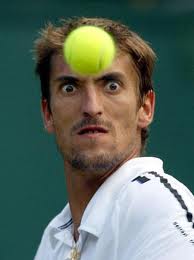Put Some Vinegar in Their Cocoa
 Tuesday, February 7, 2012 at 01:36PM
Tuesday, February 7, 2012 at 01:36PM  CAtennis
CAtennis  CAtennis.com has had the opportunity to watch a couple of mid-level professional women's events being played in Southern California. At first blush, every one of these players seems like a world-beater. The ball explodes off the string bed like a missile being launched from the battleship and, from the sound of the ball, it appears that they have fire-crackers in their strings. However, if you open your eyes and get past the intimidation factor, you realize how one-dimensional a lot of these players are. They are amazing at every shot that bounces between the knees and the chest. When such a ball comes in the middle of the court...well, fuggedaboutit. They can crank it like the best of them. However, looks can be deceiving. When the ball is high/low and away, things take a whole new dimension. Therefore, it is perplexing to see that certain strategies are not being implemented in the match by someone who is hungry to win.
CAtennis.com has had the opportunity to watch a couple of mid-level professional women's events being played in Southern California. At first blush, every one of these players seems like a world-beater. The ball explodes off the string bed like a missile being launched from the battleship and, from the sound of the ball, it appears that they have fire-crackers in their strings. However, if you open your eyes and get past the intimidation factor, you realize how one-dimensional a lot of these players are. They are amazing at every shot that bounces between the knees and the chest. When such a ball comes in the middle of the court...well, fuggedaboutit. They can crank it like the best of them. However, looks can be deceiving. When the ball is high/low and away, things take a whole new dimension. Therefore, it is perplexing to see that certain strategies are not being implemented in the match by someone who is hungry to win.
As a player, if you want to slug it out and take your chances, then so be it. Ultimately, the best ball striker that day will come out on top and there's no reason to be upset if you end up on the wrong side of the score-card. However, if you want to win, it's important to analyze your opponent's matches as well as practices in order to devise a game-plan. It is really in practices when you can pick up sublte clues about your opponent's game. For example, does she spend an inordinate amount of time crushing cross-courts? Does she rally mindlessly from the middle of the court? Well, then your mentality should be: "I don't care how good you are from that spot because the LAST thing I'm going to hit is going to be in your wheelhouse." Or "you like your forehand?! Great! Hit it a 1000 times in practice 'cause you ain't gonna be seeing any in the match". Or "you like THAT?! I'm going to give you the exact OPPOSITE of what you like; Now drink up." Remember that, for a lot of the players, practices are like safety blankets. They practice one way and they play matches the same way. Take them out of their comfort zone - be it with sharp angles, heavy topspins, deft slices or attacking plays - and they will be dumbfounbded. Why?! The answer is because a lot of players are simply too lazy to do the dirty work in practice. They are comfortable hitting certain shots and continue to work on them long after they mastered them. A good, smart player will always look to expand his/her dimensions and expand his/her mental, technical and tactical horizons. In the long-run, the "same-old, same-old" is a losing strategy. A smart player WILL find a way to punch through your defenses or to neutralize your offense. THEN WHAT?! Are you going to keep hitting harder? Try plays/strokes that you haven't practiced? Give up?
So next time you see your opponent crushing ground-strokes from a stationary position, don't despair. See how good s/he is while on the run. If your opponent is adept at covering the court side-to-side (the sign of someone with some degree of intelligence), see how good she is at covering diagonals, up-and-back and behind her (i.e., wrong-foot, or contre-pied). Some players do cover the baseline fairly well. At first, these players can be intimidating. However, get them out of this comfort zone (which for them = being on the run "coast to coast") and their games will break down. Very few players will make the effort of performing drills where they cover the deep corner (e.g. BH), the other deep corner (i.e., FH), short FH corner, deep BH corner, short BH corner, rinse-and repeat. When they are faced with situations like this in the match, they will often take the coward's way out and slap a low percentage show just to get rid of the ball. THAT's when you know that you got them! Learn to take your opponent out of the comfort zone, leae them with a bad taste in their mouths from the first point to the last, and you will win more matches and beat "better" opponents.




